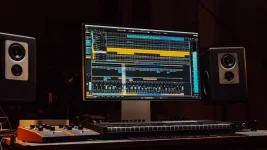Steinberg just made their popular music program better. They fixed bugs and added cool features to Cubase in version 14.0.20. The update brings changes to Pattern and Score Editors, gives more Audio Export choices, and lets you find separate sound parts like words or drum hits inside audio tracks.
Users wanted Pattern Editor to work with undo and redo buttons, and Steinberg listened. The Step Grid menu has new options to double pattern length and double resolution. Musicians can set exact limits for random changes in the parameter lane. The program also keeps Drum Machine and Pattern Editor better matched when using different pitch ranges for drum pads.
Score Editor became much stronger. It reads Dorico projects and MusicXML files from any program. Musicians can use rhythm slashes, repeat bars, numbered sections, and tremolos. These tremolos switch back and forth with grace notes. A fresh Notation Settings screen helps control automatic rhythm writing. Layout Settings give better ways to handlebar numbers. Users can switch note spelling, move the project cursor, and add playing methods for drums.
The new Audio Segment Detection helps you quickly change the volume of certain audio parts. Just hover your mouse over a waveform with the Range tool and press a key. Cubase will show each sound piece and display a volume control. Pull up or push down to make that single sound louder or quieter without changing other parts.
MixConsole looks different because the Fader section works in both main and Lower Zone views. You can show or hide it through Setup Window Layout. Many new keyboard shortcuts help with jobs like moving MIDI Parts, shifting Audio Events, using Curve Tool types, and creating Tempo and Time Signature Events. The Transport section has a Record Start at Selection mode and fresh playback controls.
Cubase lets you put Marker Tracks into wave files, saving marker spots in the file data for other programs like WaveLab to see. Version 14.0.20 crushes many known bugs listed in the release notes. The update runs fully on Windows ARM devices with Qualcomm Snapdragon X Elite chips, and Windows 11 users can run these products directly with Snapdragon X CPU technology.
Cubase 14 users can download this update for free from the Steinberg website. The update simplifies music creators' lives by adding the features they requested and making the program run more smoothly across all computer types.
Users wanted Pattern Editor to work with undo and redo buttons, and Steinberg listened. The Step Grid menu has new options to double pattern length and double resolution. Musicians can set exact limits for random changes in the parameter lane. The program also keeps Drum Machine and Pattern Editor better matched when using different pitch ranges for drum pads.
Score Editor became much stronger. It reads Dorico projects and MusicXML files from any program. Musicians can use rhythm slashes, repeat bars, numbered sections, and tremolos. These tremolos switch back and forth with grace notes. A fresh Notation Settings screen helps control automatic rhythm writing. Layout Settings give better ways to handlebar numbers. Users can switch note spelling, move the project cursor, and add playing methods for drums.
The new Audio Segment Detection helps you quickly change the volume of certain audio parts. Just hover your mouse over a waveform with the Range tool and press a key. Cubase will show each sound piece and display a volume control. Pull up or push down to make that single sound louder or quieter without changing other parts.
MixConsole looks different because the Fader section works in both main and Lower Zone views. You can show or hide it through Setup Window Layout. Many new keyboard shortcuts help with jobs like moving MIDI Parts, shifting Audio Events, using Curve Tool types, and creating Tempo and Time Signature Events. The Transport section has a Record Start at Selection mode and fresh playback controls.
Cubase lets you put Marker Tracks into wave files, saving marker spots in the file data for other programs like WaveLab to see. Version 14.0.20 crushes many known bugs listed in the release notes. The update runs fully on Windows ARM devices with Qualcomm Snapdragon X Elite chips, and Windows 11 users can run these products directly with Snapdragon X CPU technology.
Cubase 14 users can download this update for free from the Steinberg website. The update simplifies music creators' lives by adding the features they requested and making the program run more smoothly across all computer types.












